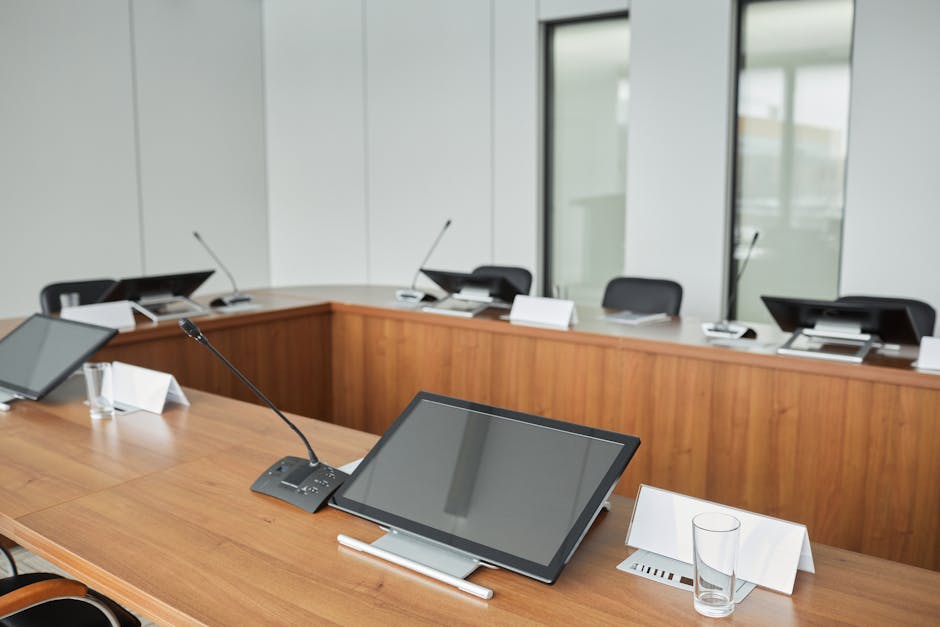Revolutionizing Workplace Efficiency: The Power of Meeting Room Management Systems
“In today's dynamic work environment, efficient space utilization is crucial. This article explores how meeting room management systems are revolutionizing workplace efficiency, streamlining conference room scheduling, and providing valuable insights for better resource allocation. ”

Revolutionizing Workplace Efficiency: The Power of Meeting Room Management Systems
In today's fast-paced business world, efficient space utilization and seamless collaboration are crucial for organizational success. As companies adapt to hybrid work models and flexible office arrangements, the need for effective meeting room management solutions has become more pressing than ever. Enter meeting room management systems – the game-changing technology that's transforming how we book, use, and optimize conference spaces.

The Evolution of Conference Room Scheduling
Gone are the days of scribbled notes on whiteboards or cumbersome spreadsheets to manage meeting spaces. Modern conference room scheduling solutions have revolutionized the way organizations handle their shared spaces. These digital platforms offer a centralized system where employees can easily view room availability, book spaces, and manage resources with just a few clicks.
Key Features of Meeting Room Management Systems
-
Real-time Availability: Users can instantly see which rooms are free and when, eliminating the frustration of double-bookings or last-minute scrambles for space.
-
Multi-device Access: Whether on a smartphone, tablet, or computer, employees can book rooms anytime, anywhere.
-
Resource Management: Beyond just rooms, these systems can handle equipment reservations, catering orders, and other meeting essentials.
-
Integration Capabilities: Many solutions integrate seamlessly with popular calendar applications and collaboration tools, ensuring a smooth workflow.
-
Analytics and Reporting: Gain valuable insights into space utilization, helping organizations make data-driven decisions about their office layout and resources.
The Benefits of Implementing a Meeting Room Management Solution
Adopting a comprehensive meeting room management system can yield significant benefits for organizations of all sizes:
1. Enhanced Productivity
By streamlining the booking process and eliminating conflicts, employees spend less time searching for available spaces and more time focusing on their work. This efficiency boost can have a substantial impact on overall productivity.
2. Improved Space Utilization
With detailed analytics on room usage, facility managers can identify underutilized spaces and make informed decisions about office layout and resource allocation. This optimization can lead to significant cost savings in the long run.
3. Better Collaboration
Easy-to-use booking systems encourage spontaneous meetings and collaboration. When employees can quickly find and reserve appropriate spaces, they're more likely to engage in face-to-face interactions, fostering innovation and teamwork.

4. Enhanced User Experience
A user-friendly interface and mobile accessibility mean that employees can manage their meeting spaces effortlessly, leading to higher satisfaction and adoption rates.
5. Reduced Administrative Burden
Automated booking processes and centralized management significantly reduce the workload on administrative staff, allowing them to focus on more strategic tasks.
Implementing a Meeting Room Management System: Best Practices
To ensure a successful rollout of your meeting room management solution, consider the following tips:
-
Choose the Right Solution: Select a platform that aligns with your organization's specific needs and integrates well with your existing tech stack.
-
Customize to Your Needs: Take advantage of features like custom room permissions and booking policies to tailor the system to your organization's unique requirements.
-
Provide Comprehensive Training: Ensure all employees are well-versed in using the new system through thorough training sessions and easily accessible documentation.
-
Encourage Adoption: Promote the benefits of the new system and consider incentivizing its use to drive adoption across the organization.
-
Regularly Review and Optimize: Use the analytics provided by the system to continuously improve your space management strategies and adapt to changing needs.

The Future of Workplace Management
As we look ahead, meeting room management systems are just the beginning of a broader trend towards smart, connected workplaces. Integration with IoT devices, AI-powered predictive analytics, and even more sophisticated space optimization tools are on the horizon.
By embracing these technologies now, organizations can position themselves at the forefront of workplace innovation, creating more efficient, collaborative, and adaptable environments for their employees.
Conclusion
In an era where agility and efficiency are paramount, meeting room management systems offer a powerful solution to common workplace challenges. By streamlining the process of conference room bookings, optimizing space utilization, and providing valuable insights, these platforms are not just improving day-to-day operations – they're reshaping the very nature of how we work and collaborate.
As we continue to navigate the complexities of modern work environments, investing in robust meeting room management solutions will be key to creating productive, flexible, and employee-friendly workspaces. The future of work is here, and it's more organized, efficient, and data-driven than ever before.